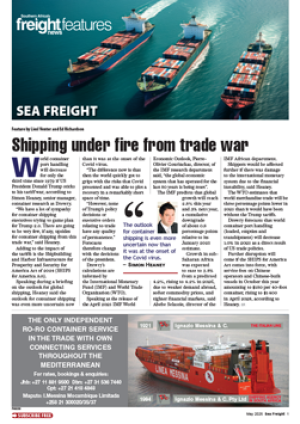Trade volumes for
Zimbabwe via Walvis
Bay have increased
significantly to more
than 2 500 tons a month,
according to Agnetha Mouton,
marketing and communications
manager for the Walvis Bay
Corridor Group.
Vehicle importers are helping
to establish the route, and at
present make up the larger
portion of this trade.
“Customers in Zimbabwe
have found a shorter and safer
alternative to transport their
vehicles to the local market.
“This new trade route
for vehicles has provided
immense benefit to the
Zimbabwe market in terms
of getting their vehicles much
sooner to their destination.”
The movement of used vehicles
from the UK into Zimbabwe
keeps hitting
new records
in terms of
volumes,
according to
Mouton.
“At the
same time the
movement of
used vehicles
has also started
to open this
trade route
for other
commodities
such as consumables,
construction materials and
equipment.
“More and more importers,
exporters, logistics companies,
traders and shipping companies
are using Walvis Bay and the
Trans-Kalahari
Corridor (TKC)
as their new
trade route,
especially when
trading with
Europe and the
Americas,” she
says.
Despite the
hype around
China and
visible presence
of Chinese in
the capital
city, Zimbabwe’s biggest trade
partners remain the United
States, Britain and countries in
the European Union.
Exports to these countries
through the TKC include nickel
and agricultural products such
as spices, coffee and tea, tobacco
and hides and skins.
“The TKC offers the Zimbabwe
market a sailing time of
approximately 18-21 days from
Walvis Bay to the US, and a
transit time of about three to
four days.”
This represents a saving of
up to a week compared to the
eastern ports, she says.
Zimbabwean imports moving
along the corridor include frozen
poultry and spare parts, in
addition to vehicles.
“Once again, it is clear
that this route offers reliability
and security in addition to cost
and time savings,” she said.
Major imports from the US to
Zimbabwe include machinery,
pharmaceutical products,
vehicles and medical equipment.
In 2009 Namibia granted
Zimbabwe about 19 000 sqm
of land to construct its own
dry port, aimed at providing
the Zimbabwe market with
sufficient and dedicated space
for all their imports and exports
at the port of Walvis Bay.
INSERT & CAPTION
The movement of used
vehicles has also started to
open this trade route for
other commodities such as
consumables, construction
materials and equipment.
– Agnetha Mouton
CAPTION
Second-hand trucks lined up on the quayside in Walvis Bay which has
become a major gateway for the importation of used vehicles in the
SADC region.

